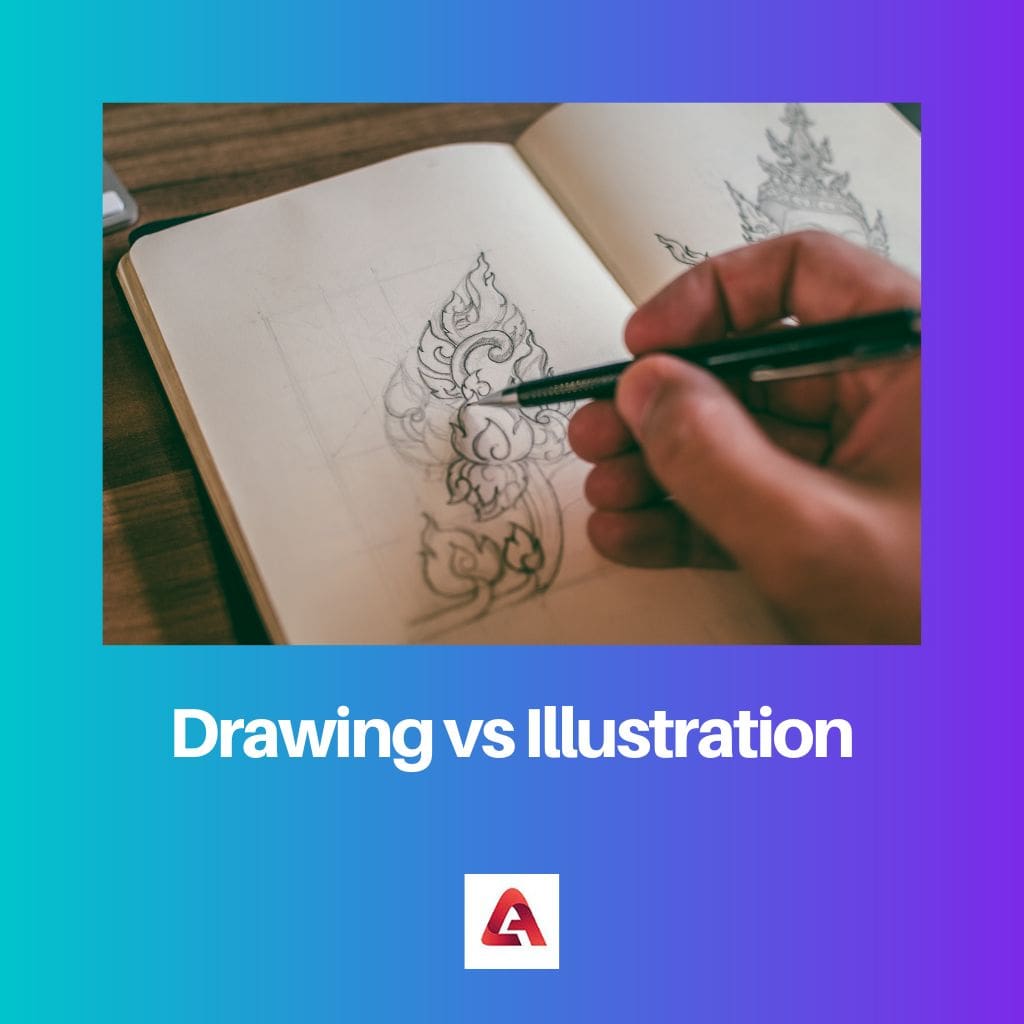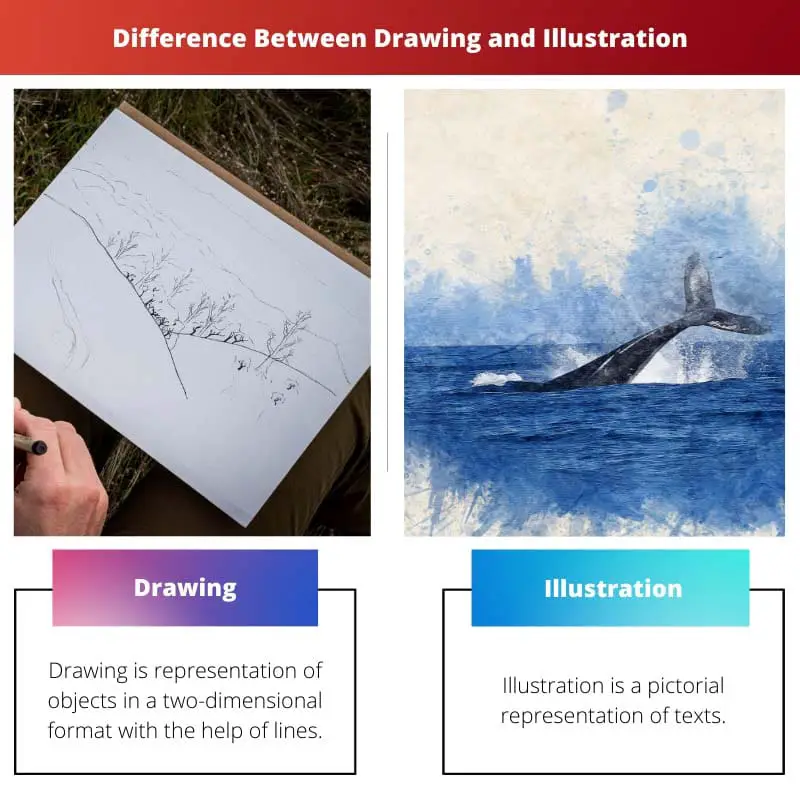The difference between drawing and illustration has confused several, but a very brief line separates drawing and illustration. Drawing and illustration are both visual representations in the form of art to convey a message or thought.
The technique via which we represent an object with the help of lines is drawing, whereas the function of clarification provides to a text is an illustration.
Key Takeaways
- Drawing is a foundational art technique that involves creating images by making marks on a surface with tools like pencils, charcoal, or ink. It focuses on depicting subjects, objects, or scenes.
- An illustration is a broader art form that includes drawings. Still, it can also involve other media and techniques serving a specific purpose, such as conveying a message, narrating a story, or enhancing a text.
- The main distinction between drawing and illustration is their scope and purpose, with drawing being a basic art technique. In contrast, illustration encompasses various techniques and is created to support or enhance other content.
Drawing vs. Illustration
The difference between drawing and illustration is that drawing is a technique of self-expression, while illustration is professional work for commercial purposes. Drawing can stay only as art, whereas a text always accompanies illustration.

Drawing is a technique of self-expression where a person can represent his feelings with the help of lines in a two-dimension format. An illustration is a technique writer, poets, and publishers use to poetry their act.
Comparison Table
| Parameter of Comparison | Drawing | Illustration |
|---|---|---|
| Definition | The drawing represents objects in a two-dimensional format with the help of lines. | The illustration is a pictorial representation of texts |
| Value | Limited commercial value | High commercial value |
| Use | For personal use | For professional use |
| Message | It can stand alone as an art | It cannot stand alone as an art |
| Expression | It is a personal or independent expression | It is an expression that is dependent on another form of art or text |
| Thought | The artist is free to use his thought of his own free will | The illustrator is restricted to using his own thought |
| Imagination | The artist is free to use his/her imagination at its peak | The illustrator is not free to use his imagination at his own will |
| Art | It contains personal thoughts and ideas; hence it is personal to the artist. | The base of an illustration is based on a text; hence there is little or no personal link. |
| Relation | It can be used as a base for an illustration | Always accompanied by a text can be a painting, drawing, or photograph |
What is Drawing?
Drawing is a form of a visual two-dimensional representation of art. It is an art technique via which an object is represented with the help of lines.
Several instruments can be used for drawing, like paper, pen, pencil, charcoal, eraser, brushes, crayons, markers, etc. Also, a standard surface, commonly paper, is required on which drawings are made. Still, several other mediums can also be used, such as wood, canvas, plastic board, etc.
Irrespective of the materials used for drawing, keen observation, and visual composition is required for the acute representation of thoughts on the medium. Drawing also has several kinds, with the help of which one can enhance their representation, such as animation, illustration architecture, and engineering.
Supremely drawing is a form of self-expression that portrays thoughts, feelings, and ideas within an artist. There are several drawing methods, such as stippling, shading, tracing, and line drawing. Drawing has a high artistic value and imagination, yet its commercial value is restricted.

What is Illustration?
An illustration is the visual representation of a text that an artist represents. An artist represents it.
It is in various forms such as painting, drawing, diagram, or photograph. An illustration enhances the visual experience and clarifies the text or theory.
Illustrations are used to publish media, including novels, posters, books, advertisements, video games, etc.
A text always accompanies illustrations; it narrates a story. The thought and creations of another author or artist inspire it.
With the help of visual illustrations, the textbook makes it easier for the readers to understand the theory. The perception created by the illustrator is as near to the text.
In ancient times, cave cravings and painting were the initial stages of illustrations, but nowadays, illustrations have become more developed, and high-tech illustrations have come into the light. Illustrating is a primary way to narrate a story through characters with faces and bodies.
Illustrations are not just limited to physical figures but also include tables, graphs, diagrams, charts, etc.

Main Differences Between Drawing and Illustration
- Drawing is a technique of self-expression where a person expresses his ideas and thoughts with the help of lines, whereas illustration is a technique used by writers, poets, and publishers o portray their act.
- A drawing depicts a personal message by the author. In the case of illustration, there is no personal message that the illustrator presents.
- Drawing can stand alone as art, whereas an illustration cannot stand alone as art.
- Drawing as a form of art has restricted commercial value, whereas an illustration has high commercial value.
- The thought and imagination put into a drawing are of the artist’s free will; however, for illustration, it is not the choice of the illustrator; he is within restricted boundaries.

- https://hal.inria.fr/docs/00/53/75/07/PDF/BCD01_screen.pdf
- https://www.mitpressjournals.org/doi/abs/10.1162/posc.2009.17.1.5

While the article effectively highlights the contrasts between drawing and illustration, it might benefit from acknowledging instances where these art forms intertwine and coalesce.
I agree. Acknowledging the overlapping aspects of drawing and illustration would provide a more nuanced understanding of their relationship.
The article’s detailed dissection of drawing and illustration enriches the understanding of these art forms, ensuring that their distinctions are comprehensively addressed.
Absolutely. The article’s thorough exploration of drawing and illustration adds clarity to the misconstrued differences between the two art forms.
I couldn’t agree more. The article’s nuanced approach provides a comprehensive understanding of drawing and illustration.
This was an incredibly informative article on the differences between drawing and illustration. The distinctions are clearly laid out and provide a better understanding of both art forms.
I agree, the article clearly defines the key differences between drawing and illustration, helping to dispel any confusion.
The article provides an in-depth comparison of drawing and illustration, shedding light on their differences. It’s a well-structured piece that dispels any confusion about these two art forms.
Absolutely, this article brings much-needed clarity to the misunderstood differences between drawing and illustration.
I couldn’t agree more. The article’s clear and concise breakdown of drawing and illustration is commendable.
While the article provides a comprehensive overview of drawing and illustration, it might benefit from acknowledging the areas where these art forms intersect and overlap.
I see your point. Acknowledging the convergence of drawing and illustration could enhance the article’s depth and accuracy.
This article fails to recognize how the boundaries between drawing and illustration are blurred. While the distinctions are outlined, there are cases where drawing and illustration overlap.
I see your point. While the article provides a general differentiation, there are indeed instances where the line between drawing and illustration becomes less clear.
The approach taken in this article to explain drawing and illustration is commendable. It highlights the nuances and scope of each art form effectively.
I found the comparison table particularly helpful. It neatly summarizes the disparities between drawing and illustration.
Absolutely agree. The detailed comparison provides valuable insight into the distinct traits of drawing and illustration.
This article delivers an insightful comparison between drawing and illustration, elucidating their distinctive features. It effectively equips readers with the knowledge to discern between these two art forms.
I share your view. The article’s analytical breakdown of drawing and illustration enhances one’s comprehension of these two art forms considerably.
This article presents a well-articulated comparison of drawing and illustration, eliminating any ambiguity regarding their distinctions. It serves as an enlightening piece for art enthusiasts and novices alike.
I concur. The article effectively dissects the differences between drawing and illustration, providing valuable insights into both art forms.
The article’s detailed exploration of drawing and illustration is highly informative and well-structured. It dispels any misconceptions and offers a comprehensive understanding of these two artistic realms.
I share your sentiments. The article’s comprehensive analysis of drawing and illustration is a valuable resource for anyone seeking clarity on these distinct art forms.
Indeed, the article’s elucidation of drawing and illustration provides a comprehensive guide to demystifying their differences.